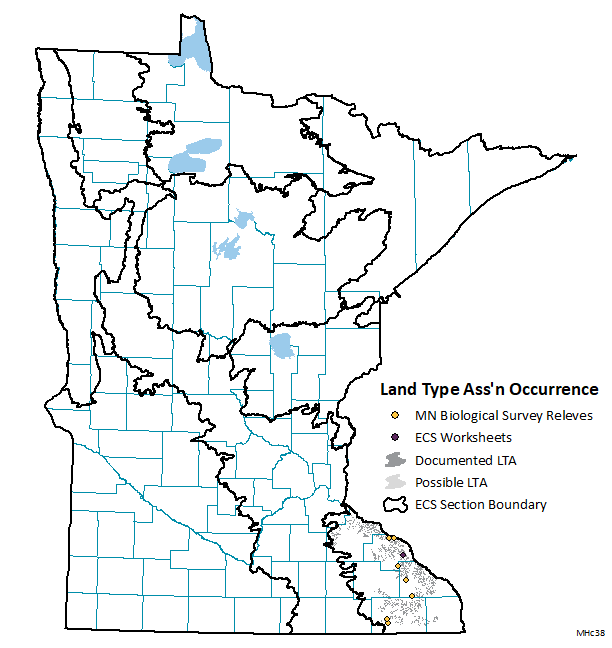Central Mesic Cold-Slope Hardwood-Conifer Forest - MHc38

Forest description
Hardwood-conifer forests on steep north-facing bluffs, often associated with algific talus slopes where cold air vents enhance the cool, moist microclimate of the community. Characterized by northern species otherwise absent in southeastern Minnesota.
Community description
MHc38 forests are a rare hardwood community located exclusively in south-east Minnesota (see map, 7 relevés, 1 ECS worksheet). All occurrences of the MHc38 community are found in the Paleozoic Plateau (PPL) section within the Elba Slopes land type association.
Distribution in Minnesota

Due to the rarity of this community, data are too limited to provide tree suitability, climate change response, tree establishment & recruitment, natural disturbance, stand dynamics & growth stage, and silvicultural strategies sections. If you are managing this native plant community, please refer to the MHs38 – Southern Mesic Oak-Basswood Forest webpage.
Vegetation structure and composition
Description is based on summary of vegetation data from 7 plots (relevés).
- Moss layer is variable; mosses and liverworts often form thick carpets over moist soil and rock. Northern species otherwise rare in southeastern Minnesota are often present.
- Ground-layer cover is generally patchy to interrupted (25-75%), with some of the patchiness due to presence of sparsely vegetated bedrock outcrops. Important species include nodding wild onion (Allium cernuum), bulbet fern (Cystopteris bulbifera), rose twisted stalk (Streptopus lanceolatus), alpine enchanter’s nightshade (Circaea alpina), columbine (Aquilegia canadensis), maidenhair fern (Adiantum pedatum), bunchberry (Cornus canadensis), and on bedrock outcrops common polypody (Polypodium virginianum) and slender cliff brake (Cryptogramma stelleri). Other common species include early meadow-rue (Thalictrum dioicum), wild ginger (Asarum canadense), zigzag goldenrod (Solidago flexicaulis), Canada mayflower (Maianthemum canadense), and sharp-lobed hepatica (Anemone acutiloba).
- Shrub-layer cover is variable, ranging from patchy to continuous (25-100%). Important shrubs and tree saplings include balsam fir. Canada yew (Taxus canadensis) common and red-berried elders (Sambucus canadensis and S. racemosa), highbush cranberry (Viburnum trilobum), dwarf alder (Rhamnus alnifolia) and white pine. Other common species include sugar maple, basswood, blue beech, chokecherry (Prunus virginiana), and downy arrowwood (Viburnum rafinesquianum).
- Subcanopy cover is generally interrupted to continuous (50-100%). Balsam fir and yellow birch are strong indicators of the community. Other common species include sugar maple, ironwood, basswood, blue beech, and paper birch.
- Canopy cover is mostly patchy to interrupted (25-75%). White pine, yellow birch, and balsam fir are strong indicators of the community. Other common species include sugar maple, white oak, northern red oak, basswood, and paper birch.
Landscape setting and soils
- Steep, loess-covered bedrock bluffs-Rare. Restricted to extremely steep, northeast- to northwest-facing, lower to middle slopes of bedrock bluffs. Most occurrences are in deep, narrow valleys where the underlying bedrock is predominantly limestone or dolomite. Substrate is naturally eroding, and outcrops of bedrock (including cliffs) and talus (small to large colluvial boulders) are commonly present. Parent material is wind-deposited silt (loess) that is generally less than 30in (75cm) deep and locally often much shallower. Deeper soils are well drained. Soil moisture regime is fresh. (Blufflands in PPL)

